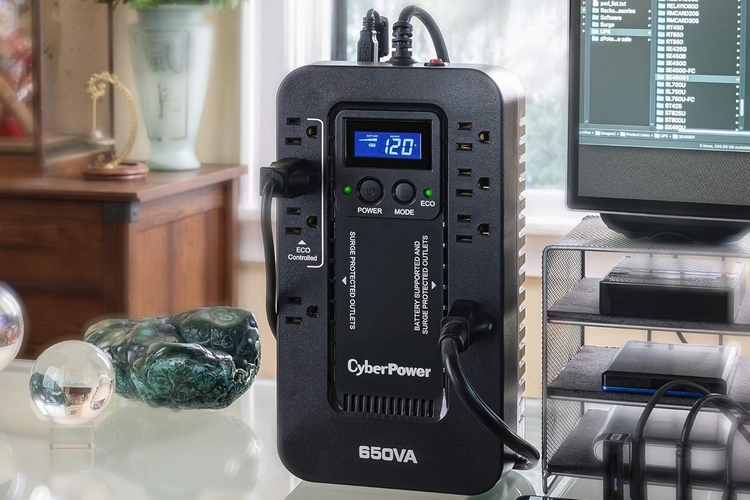
Most people don’t need an uninterruptible power supply (UPS) at home. If you do most of your work turn on a photo editing laptop, for instance, the onboard battery can keep you going even in the event of a power outage. However, there are many situations where having one can prove critical to your computing setup.
If you use a desktop computer, for instance, power outages can cut you off right in the middle of a task. Whether you’re clearing an in-game level or finishing up a proposal for a client, having a UPS on standby will give you a few minutes to finish what you’re actually doing, allowing you to create a new game save or commit your file changes before actually shutting down. Perhaps more importantly, it lets you shut down your PC normally, avoiding the hard drive crashes that can result in having your PC’s power suddenly cut off. Same goes for people who run local servers, network attached storage drives, and other similar devices.
The best UPS battery backups don’t just keep your electronics running for a short while during outages, they also protect them from fluctuations and power surges that happen throughout the course of a normal day. That’s because most UPS models are also equipped with automatic voltage regulation, which converts the fluctuating voltage from your home’s electrical system to a steady and consistent power output.
What should you look for when shopping for the best UPS battery backup? First, you need to find out the maximum power output, so you know exactly what kind of devices you can plug into it. For most people, a 300W UPS should be good enough to support standard computing setups (PC, router, modem). However, you’ll definitely want models with higher power outputs if you’re plugging in powerful servers and multiple computers.
You should also know the kind of battery the UPS houses, as it informs you how long you can run your computers in the event of power outages. Will it only give you a minute to save all files and perform a shut down? Or will it give you far longer, so you can actually finish the work before turning the computer off? You’ll also want a UPS that has battery health monitoring features, so you’ll be aware of any degradation in your battery’s quality over the years. Lastly, you’ll want to know how easy it will be to replace a UPS’ battery, since that will let you extend its lifespan for far longer, allowing you to simply buy new cells instead of getting a new UPS when the current one wears out.
Other UPS features you may want to keep an eye on include size, number of power outlets, and cable length, making sure they’re in line with your particular needs. Some UPS models will stick to those basics, although others will tack on extra capabilities, such as a built-in LCD for monitoring the device’s status, audible alarms, and more. It’s up to you to decide whether you need those extra features or not.
These are the best UPS battery backups for your home computing setup.
Amazon Basics Standby UPS
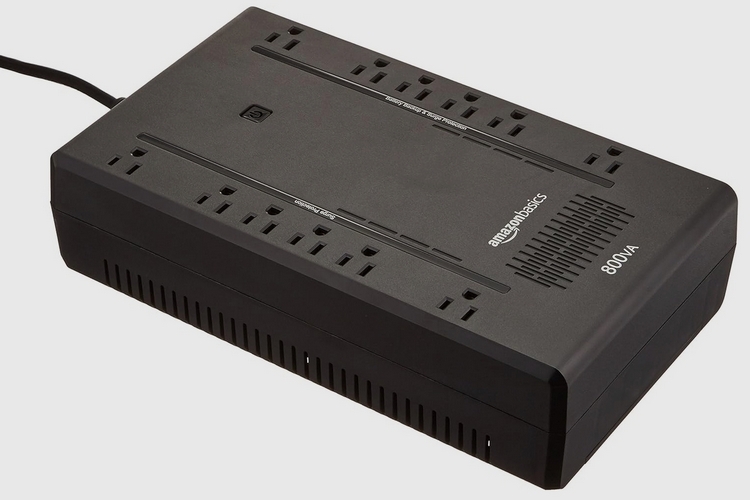
Pros
- Affordable price
- Compact size
- Generous number of outlets
Cons
- Power cord a bit short at five feet
- No AVR
Maximum output: 450W
Total outlets: 12
Battery-powered outlets: 6
At its price point, this UPS battery backup is an incredible value. However, it lacks a crucial feature many people want in a UPS, which is a AVR functionality. Do note, most modern PCs already perform AVR functions within them, so it shouldn’t be a concern if you’re hooking this up to a desktop. If you’re unbothered by that omission, it offers a decent power backup in the event of outages at a very affordable price. It’s available in three variants (255W, 360W, and 450W), with the higher wattage models offering more outlets. We tested the 450W version, which can run a normal PC for around four to six minutes during outages, depending on power consumption, which, in our opinion, is enough time to let you save your work and perform a proper shut down. From the compact form factor and the generous outlets to the excellent surge protection, there’s plenty to love here, although we do wish it came with a longer power cable.
Cyberpower EC650LCD
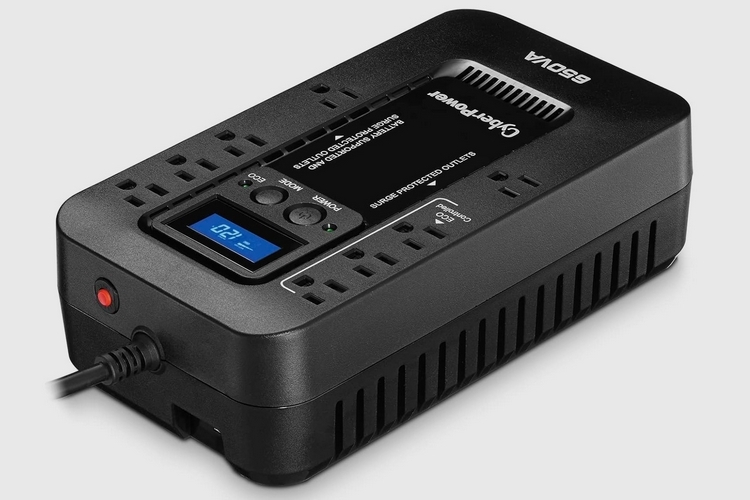
Pros
- Decent battery reserve for its size
- Compact
- Built-in LCD for power monitoring
- Eco mode for power consumption
Cons
- Power cord a bit short at five feet
- Not suitable for high-end desktops
Maximum output: 390W
Total outlets: 8
Battery-powered outlets: 4
Runtime: 8.4 minutes (half power), 2.8 minutes (full power)
Other features: Onboard LCD for power monitoring, PowerPanel Personal software, audible alarms
We’re big fans of compact UPS battery backups like the Amazon Basics above and this model right here. They’re just so much easier to integrate into your computing setup. At 390W, there’s enough output here to let you shut down most desktop PCs safely during outages, although it, admittedly, only gives you a couple minutes to finish up whatever you’re doing before power runs out. It also uses simulated sine wave output to ensure safe power delivery at all times, while an LCD panel displays real-time information on power and battery conditions. We really like the Eco outlets, designed to plug in peripherals like speakers and monitors, which the UPS can automatically turn off when it detects the main PC isn’t running. It’s a really nice touch. You can also monitor the power and battery conditions from your PC using the outfit’s PowerPanel Personal software.
Cyberpower CP900AVR
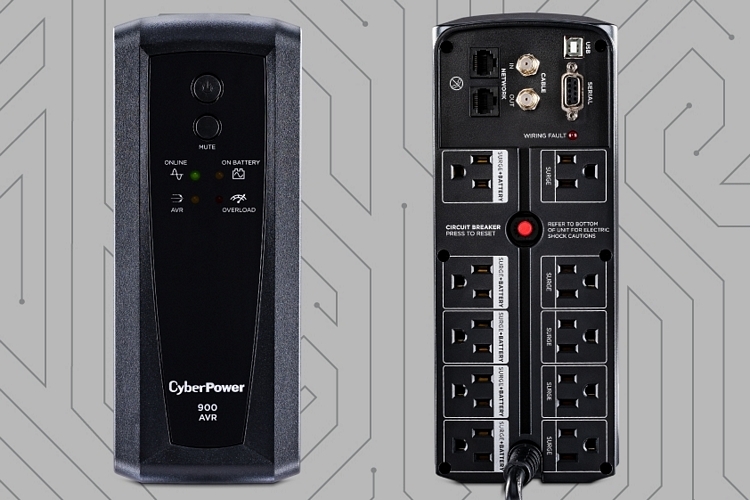
Pros
- Five minute runtime at full power output
- Built-in AVR
- Great price-to-features ratio
- User-replaceable battery
Cons
- No onboard display
- Expensive battery replacement
Maximum output: 560W
Total outlets: 10
Battery-powered outlets: 5
Runtime: 16 minutes (half power), 5 minutes (full power)
Other features: Replaceable battery, PowerPanel Personal software, audible alarms, accessory ports (USB, coax, serial, LAN)

At its price, this desktop-style UPS battery backup feels like a really good value for the features it brings to the table. For instance, it’s the first one in the list with AVR function, while allowing you to use your devices for up to five minutes after an outage even when you’re using up the battery to the full 560W capacity. It has 10 outlets in the back, including five battery-backed slots, while using LED indicators to let you know of battery and power status. Like other Cyberpower UPS devices, it’s compatible with the outfit’s PowerPanel Personal software for monitoring the system from your computer, while also having audible alarms that you can turn off if you don’t like those. It’s very intuitive to use, as well, although the tower form factor isn’t the easiest to find room for in cramped setups. We love the fact that the battery is pretty easy to replace, though it’s fair to note that the replacement is quite expensive (only $30 cheaper than the whole thing). Aside from the power outlets, it has USB ports for easily connecting to your PC, coaxial cables for connecting to a modem, a serial port for connecting a printer, and even two LAN ports if you want to be able to check it from your network.
Cyberpower CP1500PFCLCD
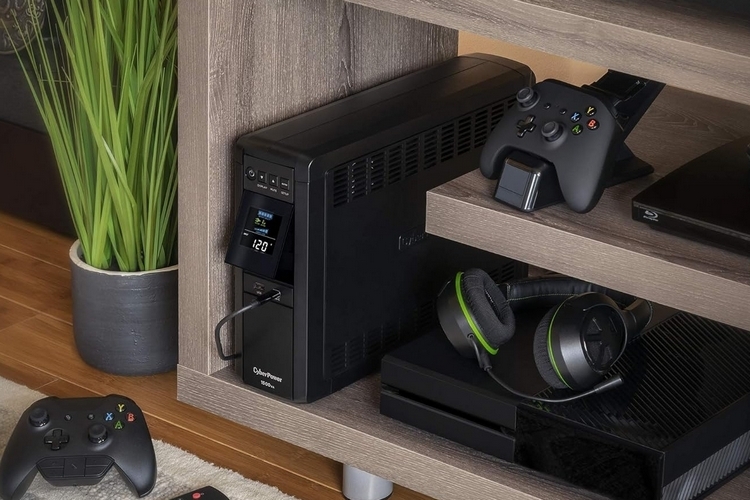
Pros
- Plenty of outlets, including USB charging ports
- Tilting color LCD
- High power output
- Remote monitoring support
Cons
- Relatively short runtime at full power
- Power cord a bit short at five feet
Maximum output: 1000W
Total outlets: 12
Battery-powered outlets: 6
Runtime: 10 minutes (half power), 2.5 minutes (full power)
Other features: Replaceable battery, PowerPanel Business software, audible alarms, accessory ports (USB, coax, serial, LAN), remote monitoring expansion port
Many UPS battery backups use simulated sine wave output for safe power delivery. This one, though, isn’t simulated, instead bringing true sine wave output, making it better for powering sensitive equipment that might not do well with slightly choppy electrical waveforms. It has 12 power outlets, including six battery-backed ones, and two USB charging ports, as well as full AVR functionality, so it’s quite the powerful accessory. There’s a built-in color LCD that shows battery and power readings, as well as alerts users of any potential issues (it can also use audible alarms if you want that). You can even tilt that LCD up to 22 degrees, making it easier to see even if you decide to put it down on the floor. Runtime during outages is pretty limited here, only giving you 2.5 minutes to finish your work and save everything at full power. Do note, this is meant for commercial rather than household use, which is why it uses the outfit’s PowerPanel Business software instead of the Personal version. it also comes with a variety of accessory ports, as well as an expansion port for an RMCARD205 so you can monitor the UPS remotely.
APC Back-UPS Pro 1500 S
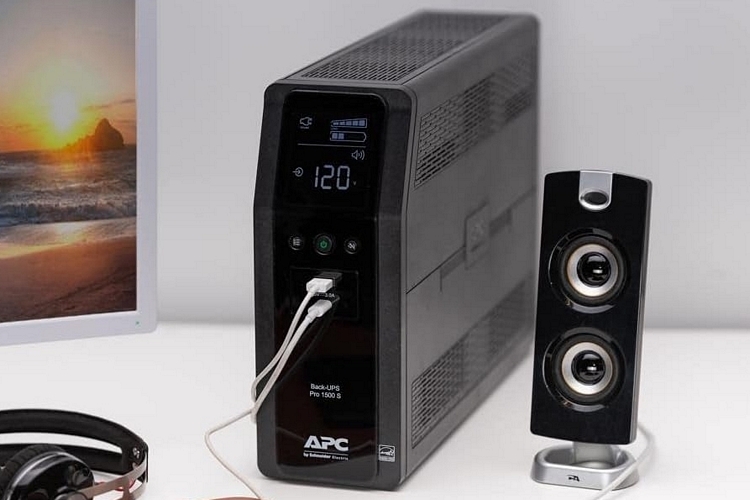
Pros
- Six battery-powered outlets
- Remote monitoring and shutdown
- Automatic safe shutdown when left unattended
Cons
- Bulky size
Maximum output: 900W
Total outlets: 12
Battery-powered outlets: 6
Other features: Replaceable battery, PowerChute software, audible alarms, accessory ports (USB, coax, serial, LAN), automatic safe shutdown
Like other more expensive UPS battery backups, this one has power monitoring software, AVR functionality, and true sine wave output. It has 10 power outlets, including six connected to the onboard battery, as well as two USB slots for charging small devices. All the niceties of UPS models at this price range are also onboard, including an LCD display for status monitoring, a user-replaceable battery, network line surge protection, coaxial line surge protection, and a free WIndows software for monitoring it on your computer. It also supports remote shutdowns, as well as an automatic shutdown feature that gently and safely powers down any connected equipment when they’re unattended as soon as low battery reserves are detected.



